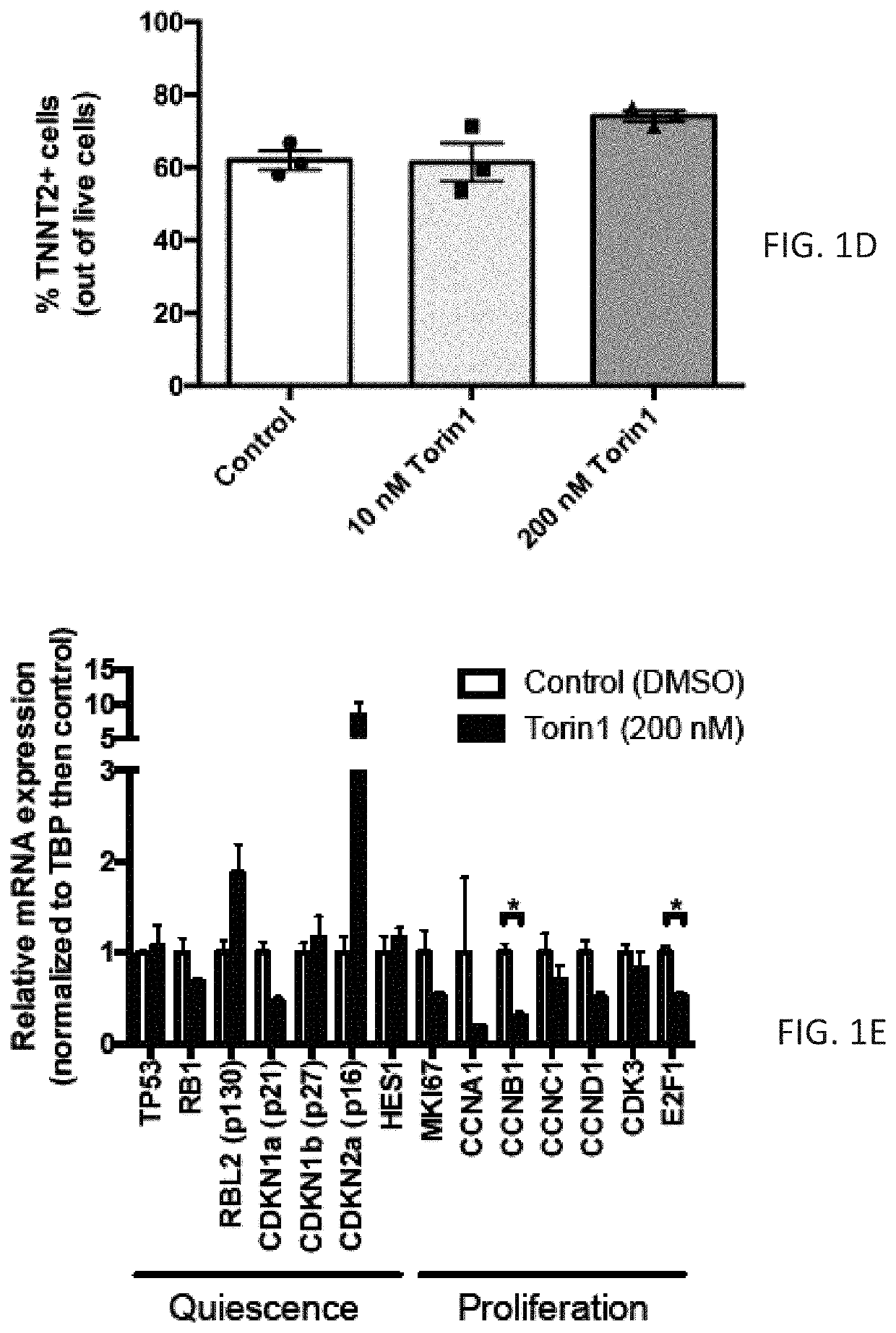Cardiomyocytes and compositions and methods for producing the same
a technology of myocytes and compositions, applied in the field of cardiac myocytes and compositions and methods for producing the same, can solve problems such as potentially life-threatening ventricular arrhythmias
- Summary
- Abstract
- Description
- Claims
- Application Information
AI Technical Summary
Benefits of technology
Problems solved by technology
Method used
Image
Examples
example 1
n of mTOR Signaling Enhances Maturation of Cardiomyocytes Derived from Human Induced Pluripotent Stem Cells Via p53-Induced Quiescence
[0304]Human embryonic stem cells (ESCs) or induced pluripotent stem cells (iPSCs) are capable of producing highly pure cardiomyocyte populations as determined by expression of cardiac troponin (1). However, these protocols produce immature cardiomyocytes that more closely resemble the fetal state, with less organized sarcomere structure, lower maximum contractile force, slower upstroke velocity, higher resting potential, absent T-tubules, and continued reliance on glycolysis as the primary energy source (2). Notably, delivery of immature ESC-derived cardiomyocytes to large animal models (macaque monkeys or Yorkshire pigs) leads to an increased risk of potentially life-threatening ventricular arrhythmias compared to vehicle control (3, 4). Inadequate maturation of stem cell-derived cardiomyocytes is a major barrier to clinical translation of cell thera...
example 2
Quiescence and Cardiomyocyte Maturation
[0391]Stem cell approaches to treat heart failure will require production of mature cardiomyocytes (CMs) to improve systolic heart function and reduce the incidence of ventricular arrhythmias. However, CMs derived from embryonic or induced pluripotent stem cells (ESCs or iPSCs, respectively) remain functionally immature using current differentiation protocols (1). These immature CMs when delivered to adult large animal models result in potentially life-threatening ventricular arrhythmias (2-4). Successful translation of cell therapies for cardiovascular disease will require improved methods to mature stem cell-derived CMs.
[0392]During development, CMs undergo a shift from a proliferative state as a fetus, to a more mature but quiescent state after birth (5). This shift is accompanied by a change in energy metabolism, with fetal CMs deriving energy primarily through glycolysis, and adult CMs deriving energy primarily through fatty acid oxidation...
example 3
ion of the PI3K / Akt / mTOR Pathway to Enhance Maturation of Cardiomyocytes Derived from Stem Cells
Background
[0540]Stem cell approaches to treat chronic heart failure will require production of ventricular cardiomyocytes to improve systolic heart function and reduce the incidence of ventricular arrhythmias. However, cardiomyocytes derived from embryonic or induced pluripotent stem cells (ESCs or iPSCs, respectively) remain functionally immature using current differentiation protocols. These immature cardiomyocytes display automaticity or pacemaker-like activity which results in potentially life-threatening ventricular arrhythmias when delivered to adult animal models and also have a less organized sarcomere structure preventing adequate contractile force (1, 2). Successful translation of stem cell-derived therapies for treatment of cardiovascular disease will require developing improved methods for maturation of stem cell-derived cardiomyocytes.
Summary
[0541]The phosphoinositide 3-kinas...
PUM
 Login to View More
Login to View More Abstract
Description
Claims
Application Information
 Login to View More
Login to View More - R&D
- Intellectual Property
- Life Sciences
- Materials
- Tech Scout
- Unparalleled Data Quality
- Higher Quality Content
- 60% Fewer Hallucinations
Browse by: Latest US Patents, China's latest patents, Technical Efficacy Thesaurus, Application Domain, Technology Topic, Popular Technical Reports.
© 2025 PatSnap. All rights reserved.Legal|Privacy policy|Modern Slavery Act Transparency Statement|Sitemap|About US| Contact US: help@patsnap.com



